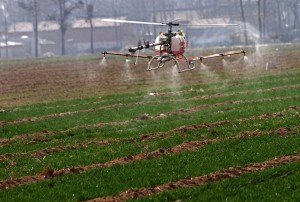File
The Pakistani province of Sindh has a colossal locust problem. Hometown researcher Shahzad Nahiyoon has a solution from on high.
For the past 30 years, farmers in Malir have suffered devastating insect attacks without the benefit of pesticide spraying. A shortage of manned aircraft prevented aerial crop-dusting, resulting in thousands of acres of decimated crops.
Nahiyoon, a plant-protection expert, has launched a UAV crop-spray initiative, leveraging his status as the first known agricultural drone pilot in Pakistan.
His drones can spray between six to 10 hectares per hour, using tanks that can hold up to 20 liters of pesticides.
“The UAV has emerged as a capable plant protector because it has high operational efficiency, high speed and low drift,” Nahiyoon said in an interview with the Express Tribune.
“UAVs are more suitable for complex terrain and small-sized farms with separate plots,” he added.
A native of Sindh, Nahiyoon has spent the last few years earning his doctorate in pesticides sciences at the Chinese Academy of Agricultural Sciences.
At the academy, Nahiyoon learned cutting-edge techniques in drone-based plant protection. In 2016, he earned a master’s at the Sindh Agriculture University in his hometown of Tando Jam. In short, Nahiyoon knows his drones.
“In contrast to the commonly used manned fixed-wing aircraft in the United States, UAVs do not require a take-off airport which makes them much more cost-effective,” Nahiyoon told the Express Tribune.
Before Nahiyoon arrived on the scene, the provincial government had requested three helicopters, 32 spraying vehicles and pesticides from the Pakistani federal government – an expensive and potentially dangerous proposition.
“[Drones] have higher work efficiency, lower operator exposure and improved ability to spray chemicals in a timely and highly spatially-resolved manner.”
Market research predicts the agricultural drone market could expand to a $4.2 billion industry by 2022, representing a growth rate of 30 percent. Other reports peg the ag drone market at $2.9 billion by 2021 – up 28 percent from a 2015 valuation of $673 million.
Jason is a longstanding contributor to DroneLife with an avid interest in all things tech. He focuses on anti-drone technologies and the public safety sector; police, fire, and search and rescue.
Beginning his career as a journalist in 1996, Jason has since written and edited thousands of engaging news articles, blog posts, press releases and online content.
Email Jason
TWITTER:@JasonPReagan
Subscribe to DroneLife here.
https://dronelife.com/2019/12/03/crop-spraying-drones-tackle-locust-swarms-in-pakistan/
 Unmanned Aerial Vehicle The latest drone news
Unmanned Aerial Vehicle The latest drone news





